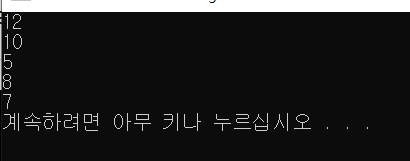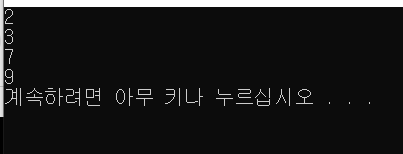#define _CRT_SECURE_NO_WARNINGS
#include <stdio.h>
#define INF 10000
int arr[INF];
int count = 0;
void addBack(int data) {
arr[ count ] = data;
count++;
}
void addFirst(int data) {
for (int i = count; i >= 1; i--) {
arr[i] = arr[i - 1];
}
arr[0] = data;
count++;
}
void show() {
for (int i = 0; i < count; i++) {
printf("%d\n", arr[i]);
};
}
int main(void) {
addBack(5);
addBack(8);
addBack(7);
addFirst(10);
addFirst(12);
show();
system("pause");
return 0;
}
1. 연결 리스트
1) 포인터를 이용해 단방향적으로 다음 노드를 가리킴
2) 일반적으로 연결 리스트의 시작 노드를 헤드라고 하며 별도로 관리
3) 다음 노드가 없는 끝 노드의 다음 위치 값으로도 NULL을 넣음
#define _CRT_SECURE_NO_WARNINGS
#include <stdio.h>
#include <stdlib.h>
typedef struct { // 구조체 선언
int data;
struct Node *next;
} Node;
Node *head; // 연결리스트는 head 노드로 부터 출발
int main(void) {
head = (Node*)malloc(sizeof(Node)); // 구조체 만큼의 필요한 메모리 할당 받음
Node *node1 = (Node*)malloc(sizeof(Node)); // 첫번째 노드 하나의 노드가 들어간 공간 만듦
node1->data = 1;
Node *node2 = (Node*)malloc(sizeof(Node));
node2->data = 2;
head->next = node1; // next로 데이터 연결, head에서 node1으로 이어질 수 있도록
node1->next = node2; // node1에서 node2로 이어질 수 있도록
node2->next = NULL; // 항상 끝노드는 next 값으로 null값을 가짐으로서 더이상 연결되어 있는게 없다는 것을 알려줌
Node *cur = head->next; // cur라는 이름의 포인터변수를 이용해서 전체 원소의 값들을 한개씩 다 출력
while (cur != NULL) {
printf("%d\n", cur->data); // 하나씩 출력하고
cur = cur->next; // 그 다음원소로 이동하는 방식
}
system("pause");
return 0;
}- 삽입과 삭제가 배열에 비해서 간단하다는 장점이 있음
- 배열과 다르게 특정 인덱스로 즉시 접근하지 못하며, 원소를 차례대로 검색해야함.
- 추가적인 포인터 변수가 사용되므로 메모리 공간이 낭비됨
#define _CRT_SECURE_NO_WARNINGS
#include <stdio.h>
#include <stdlib.h>
typedef struct { // 구조체 선언
int data;
struct Node *next;
} Node;
Node *head; // 연결리스트는 head 노드로 부터 출발
// 연결 리스트 삽입 함수
void addFront(Node* root, int data) {
Node* node = (Node*)malloc(sizeof(Node));
node->data = data;
node->next = root->next;
root->next = node;
}
// 연결 리스트 삭제 함수
void removeFront(Node* root) {
Node* front = root->next;
root->next = front->next;
free(front); // 연결 리스트 삭제 함수
}
// 연결 리스트 메모리 해제함수
void freeAll(Node* root) {
Node* cur = head->next;
while (cur != NULL) {
Node* next = cur->next;
free(cur);
cur = next;
}
}
// 연결 리스트 전체 출력 함수
void showAll(Node* root) {
Node* cur = head->next;
while (cur != NULL) {
printf("%d\n", cur->data);
cur = cur->next;
}
}
int main(void) {
head = (Node*)malloc(sizeof(Node));
head->next = NULL;
addFront(head, 2);
addFront(head, 1);
addFront(head, 7);
addFront(head, 9);
addFront(head, 8);
removeFront(head);
showAll(head);
freeAll(head);
system("pause");
return 0;
}
연결 리스트
- 연결 리스트는 데이터를 선형적으로 저장하고 처리하는 한 방법
- 기존에 배열을 이용했을 때보다 삽입과 삭제가 많은 경우에서 효율적
- 다만 특정한 인덱스를 바로 참조해야 할 때가 많다면 배열을 이용하는 것이 효율적
2. 양방향 연결 리스트
1) 양방향 연결 리스트는 머리(Head)와 꼬리(Tail)를 모두 가진다는 특징이 있음
2) 양방향 연결 리스트의 각 노드는 앞 노드와 뒤 노드의 정보를 모두 저장하고 있음
#define _CRT_SECURE_NO_WARNINGS
#include <stdio.h>
#include <stdlib.h>
typedef struct { // 구조체 선언
int data;
struct Node* prev;
struct Node* next;
} Node;
Node* head, * tail;
// 양방향 연결 리스트 삽입 함수
void insert(int data) {
Node* node = (Node*)malloc(sizeof(Node));
node->data = data;
Node* cur;
cur = head->next;
while (cur->data < data && cur != tail) {
cur = cur->next;
}
Node* prev = cur->prev; // 삽입할 노드의 바로 앞쪽 노드 prev로 설정
prev->next = node; // 앞에 있는 노드의 next가 현재 삽입할 노드가 되고
node->prev = prev; // 노드의 prev가 앞쪽에 있는 노드가 되고
cur->prev = node; // 뒤에 있는 노드의 prev가 노드가 되고
node->next = cur; // 노드의 next가 뒤에 있는 노드가 됨
}
// 양방향 연결 리스트 삭제 함수
void removeFront() {
Node* node = head->next;
head->next = node->next;
Node* next = node->next;
next->prev = head;
free(node);
}
// 양방향 연결 리스트 전체 출력 함수
void show() {
Node* cur = head->next;
while (cur != tail) {
printf("%d\n", cur->data);
cur = cur->next;
}
}
int main(void) {
// head, tail 모두 할당
head = (Node*)malloc(sizeof(Node));
tail = (Node*)malloc(sizeof(Node));
head->next = tail;
head->prev = head;
tail->next = tail;
tail->prev = head;
insert(2);
insert(1);
insert(3);
insert(9);
insert(7);
removeFront();
show();
system("pause");
return 0;
}
양방향 연결 리스트
- 양방향 연결 리스트에서는 각 노드가 앞 노드와 뒤 노드의 정보를 저장하고 있음
- 양방향 연결 리스트를 이용하면 리스트의 앞에서부터 혹은 뒤에서부터 모두 접근할 수 있음
